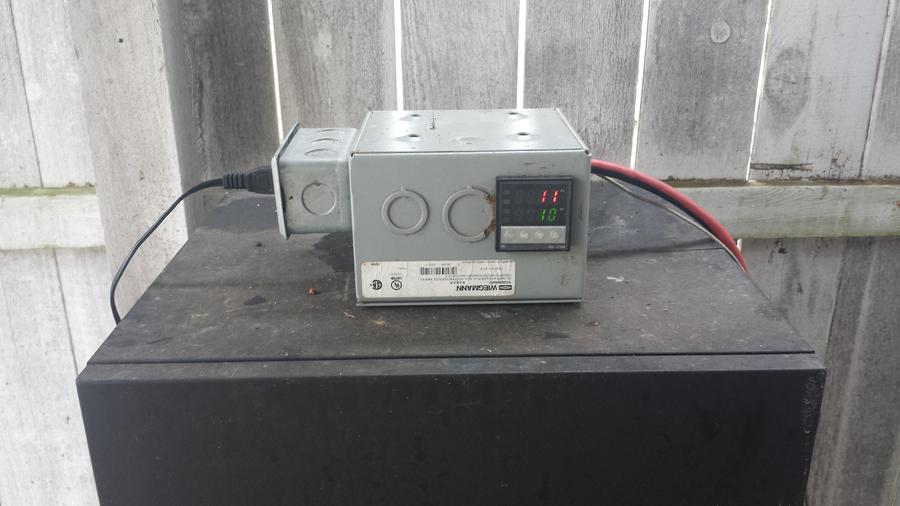So let's get started.
So as a bit of a background, I basically caught the smokers bug about a year ago. Since then I've modified my smoker to fit my needs, but also I wanted to keep the core of the
Masterbuilt Smoker intact so that it could be used in the same manner as it was built, and not to damage the cabinet in any way and to keep it stock.
Another thing I was trying to achieve is to be able to run the stock heating element to modify the heat inside of the cabinet if there was a situation that would arise where I needed a bit higher temperature, such as some methods of curing bacon.
Also, I wanted to make my modifications so that they could be used with other smokers, or even with a custom built smoker.
I've been doing more cold smoking, and even with the PID modification, I still wasn't getting the results I wanted. The lower temp I was achieving wasn't enough to keep sufficient smoke going for the string cheese I've been playing with.
So ultimately I wanted a cheap and easy fix. I decided on the Soldering Iron method and this is how I designed it.
First off, I found the sufficient can. Luckily we hadn't had spaghetti in a while, so we had spaghetti dinner last night.
I then used a modern can opener in order to create a lid for the can to make it safe and reusable.
Here is the can with the new lid.
Then of course, I used a drill bit to create a hole in the can and lid. I then made sure the hole was suitable for the soldering iron.
Next, for my test run, I decided to use oak chunks that I made from an oak log I have in my yard. I didn't want to use my better peach chunks as they aren't as readily available. ( I love using peach by the way )
The chips were of varying size and were slightly damp being on the outside of the log.
Next, I inserted the soldering iron. The soldering iron was a $6.00, low end model I purchased at an auto parts store. It is rated to 750* Fahrenheit. When inserting the soldering iron, I made sure to only insert it far enough to allow the vent holes in the iron to stay outside of the can. I figured this would keep ash and embers out of the iron, and not destroy the wires inside of it.
Next, I removed the drip pan from the
MasterBuilt smoker. I made sure to clean the worst of the grease from the inside bottom pan of the smoker in order to make sure any residue wouldn't drip into my can and contaminate my wood chips. Whether or not this is necessary, I'm not exactly sure, but wanted to be on the safe side.
I then wedged the can against the bottom of the smoker, aligning the hole in the lid of the can, with the drip hole in the smoker. For this test run, I just used a piece of broken concrete that was of suitable size.
Here you can just make out the hole in the top of the can aligned with the drip hole in the cabinet.
I then plugged the soldering iron into my homemade PID controller. My goal was to watch the temperature at cooking level to see if there was any change in temperature in the cooking area.
I then monitored the situation at hand.....
1.) In 15 minutes I had a small ribbon of smoke being emitted from the can.
2.) In 30 Minutes I had a full roll of smoke coming from the opening.
3.) Within and hour, the cabinet was emitting smoke very well.
To ensure that the chips were being processed by the soldering iron and making good contact, I occasionally poked through the drip hole, into the can, with a piece of wire to "stir" the wood chips. In all reality though, I don't think this was necessary.
During the test run, I monitored the outside air temperature in conjunction with the temperature inside the cabinet. I wanted to see if the soldering iron, can, and the smoke had any affect.
During my 5 hour test run, the PID probe had reach a maximum reading of 15*C, or 59*F. So the chips and the soldering iron did affect the temperature of the inside of the cabinet, but was still well in range of cold smoking.
After my initial 5 hour run, I removed the wood chips from the can to determine how much of the chips were processed. What I found is that a small percentage was processed, and I can only assume that I could possibly get 12 hours of run time from the chips.
As soon as my instructional video is converted, uploaded and complete, I will show each step in the video, along with a visual of the smoke output from this modification.
Overall, the test run was a great success.
Here is the test run video.
Instructional Video, I was trying to merge the above video and the instructional, but was having too many issues.


















